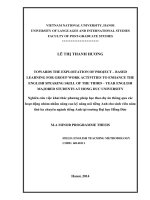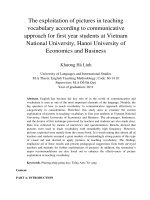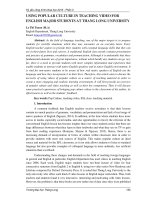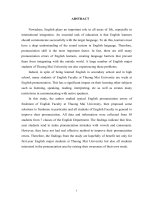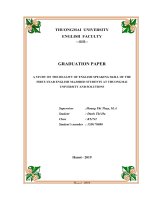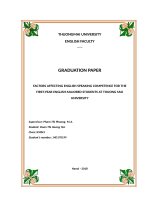Common errors in writing essay of english majored students at vietnam national university of agriculture
Bạn đang xem bản rút gọn của tài liệu. Xem và tải ngay bản đầy đủ của tài liệu tại đây (650.58 KB, 56 trang )
VIET NAM NATIONAL UNIVERSITY OF AGRICULTURE
FACULTY OF EDUCATION AND FOREIGN LANGUAGES
BA THESIS
COMMON ERRORS IN WRITING ESSAY OF
ENGLISH-MAJORED STUDENTS AT VIETNAM
NATIONAL UNIVERSITY OF AGRICULTURE
NHỮNG LỖI THƯỜNG GẶP KHI VIẾT BÀI LUẬN
CỦA SINH VIÊN CHUYÊN NGÀNH NGÔN NGỮ ANH
TẠI HỌC VIỆN NÔNG NGHIỆP VIỆT NAM
Student
: Than Thi Hoan
Student code
: 621242
Major
: English Linguistics
Supervisor
: Tran Thi Tuyet Mai, M.A
Hanoi – 2021
VIET NAM NATIONAL UNIVERSITY OF AGRICULTURE
FACULTY OF EDUCATION AND FOREIGN LANGUAGES
BA THESIS
COMMON ERRORS IN WRITING ESSAY OF
ENGLISH-MAJORED STUDENTS AT VIETNAM
NATIONAL UNIVERSITY OF AGRICULTURE
NHỮNG LỖI THƯỜNG GẶP KHI VIẾT BÀI LUẬN
CỦA SINH VIÊN CHUYÊN NGÀNH NGÔN NGỮ ANH
TẠI HỌC VIỆN NÔNG NGHIỆP VIỆT NAM
Student
: Than Thi Hoan
Student code
: 621242
Major
: English Linguistics
Supervisor
: Tran Thi Tuyet Mai, M.A
Hanoi – 2021
CERTIFICATE OF ORIGINALITY
I, the undersigned, hereby certify my authority of the study project report
entitled “Common errors in writing essay of English-majored students at
Vietnam National University of Agriculture” submitted in partial fulfillment of
the requirements for the degree of Bachelor in English Language. Except where
the reference is indicated, no other person‟s work has been used without due
acknowledgement in the text of the thesis.
Hanoi 2021.
Than Thi Hoan
Approved by
SUPPERVISOR
(Signature and full name)
Date……………………..
i
ABSTRACT
Writing is a very important skill in teaching and learning English especially
academic essays writing. However, the second- year English major at Vietnam
National University of Agriculture still encounter a lot of many difficulties in
academic essay writing. In order to have an overview onto this problem, I
decided to do a research on “Common errors in writing essay of the Englishmajored students at VNUA.” In this study, basing on the score of writing
subject 3, the researcher selected 80 students with scores from 4 to 7 to survey
and 2 teachers, information was collected and analyzed. The result gained from
the analysis of students‟ questionnaire has revealed five common errors made by
second year English major and five actual causes to these categories of errors.
Suggested solutions on how to deal with students” errors are also proposed.
ii
ACKNOWLEDGEMENT
Firstly, I would like to express my gratitude towards teachers at Faculty of
Education and Foreign Languages -Vietnam National University of Agriculture.
Especially, I would like to express my deepest thanks to my supervisor Ms.Tran
Thi Tuyet Mai who has enthusiastically helped and encouraged me during the
period of writing this research paper. Without her experienced guidance,
valuable comments and tireless help, I cannot complete the study on time.
My warmest thanks also to second - year English major at Faculty of Education
and Foreign Languages, who helped me collect the data. If it had not been their
support, this research would not have been accomplished.
Finally, gratitude is given to my family and friends who encouraged and
supported me throughout conducting this paper process. If hadn‟t been for their
help, my study couldn‟t have been successfully completed.
iii
TABLE OF CONTENT
CERTIFICATE OF ORIGINALITY ..................................................................... i
ABSTRACT .......................................................................................................... ii
ACKNOWLEDGEMENT ................................................................................... iii
TABLE OF CONTENT ....................................................................................... iv
LIST OF TABLES AND FIGURES ................................................................... vii
LIST OF ABBREVIATIONS ............................................................................ viii
PART 1: INTRODUCTION ................................................................................. 1
1.1. Rationale .......................................................................................................................... 1
1.2. Aims and objectives of the study ............................................................................... 2
1.3. Research questions ........................................................................................................ 2
1.4. Scope of the study ......................................................................................................... 2
1.5. Significance of the study ............................................................................................. 3
1.6. Design of the study........................................................................................................ 3
PART 2: DEVELOPMENT .................................................................................. 5
Chapter 1: LITERATURE REVIEW .................................................................... 5
1.1 Review of the previous studies.................................................................................... 5
1.1.1 In the world…………………………………………… ... ………………...5
1.1.2. In Vietnam ................................................................................................................... 7
1.2. Review of theoretical background............................................................................. 7
1.2.1 Definition of errors ..................................................................................................... 7
1.2.2 Classification of written errors ................................................................................ 8
1.2.3 Causes of written errors ........................................................................................... 10
iv
1.3. Summary ........................................................................................................................ 13
Chapter 2: METHODOLOGY ............................................................................ 14
2.1. Research governing principles ................................................................................. 14
2.1.1 Research question(s)................................................................................................. 14
2.1.2 Principles/ criteria for data collection and data analysis…………………14
2.2. Research methods ........................................................................................................ 14
2.2.1. Research methodology............................................................................................ 14
2.2.2 Research setting/context .......................................................................................... 14
2.2.3. Data collection .......................................................................................................... 15
2.3. Summary ........................................................................................................................ 15
Chapter 3: FINDINGS AND DISCUSSION ...................................................... 16
3.1. General information .................................................................................................... 16
Participants ........................................................................................................................... 16
How often do you write essay? ....................................................................................... 17
Do you use proofreading software when writing? ..................................................... 18
3.2. FINDING AND DISCUSSION 1 ........................................................................... 19
3.2.1: Grammar errors ........................................................................................................ 20
3.2.2 Errors related to general items ............................................................................... 21
3.2.3 Lexical item ................................................................................................................ 23
3.2.4 Mechanic errors ......................................................................................................... 25
3.2.5: Sematic errors ........................................................................................................... 26
3.3. FINDING AND DISCUSSION 2 ........................................................................... 28
3.3.1 Mother tongue interference..................................................................................... 30
3.3.2 Overgeneralization .................................................................................................... 32
3.3.3 Ignorance of rule restrictions: ................................................................................ 32
3.3.4 Incomplete application of rules ............................................................................. 33
3.3.5 False concepts hypothesized................................................................................... 33
3.4. Summary ...................................................................................................... 34
v
PART 3: CONCLUSION .................................................................................... 34
1. Recapitulation .................................................................................................................. 35
2. Concluding remarks........................................................................................................ 36
3. Limitation of the current research: ............................................................................. 36
4. Recommendations future research and solutions .................................................... 36
4.1 Recommendations future research ........................................................................... 36
4.2: Solutions ........................................................................................................................ 37
4.2.1. Peer-correction .......................................................................................................... 37
4.2.2 Teacher correction..................................................................................................... 38
REFERENCES .................................................................................................... 39
APPENDIX (If any) ............................................................................................ 41
vi
LIST OF TABLES AND FIGURES
LIST OF TABLE
Table 1: Written errors of second- year students at VNUA as synthesized
from teachers‟ questionnaire ................................................................... 19
Table2: Typical examples of spelling errors are provided by the teacher .......... 22
Table 3: Typical examples of lexical items ........................................................ 24
Table 4: Examples of common mechanics errors ............................................... 26
Table 5: Teachers‟ rating the significance of causes to students common
written errors ........................................................................................... 28
LIST OF FIGURE
Figure 1: Participant ............................................................................................ 16
Figure 2: How often do you write essay ............................................................. 17
Figure 3: Use proofreading software when writing ............................................ 18
Figure5:Grammar errors Grammatical errors obtained from survey questions
for students……………………………………………......................... 21
Figure 6: Written errors belonging to general items ........................................... 22
Figure 7: Lexical items ........................................................................................ 23
Figure 8: Mechanic errors ................................................................................... 25
Figures 9: Semantic errors................................................................................... 26
Figure 10 : The popularity of each kind of causes to students‟ common
written errors ........................................................................................... 29
vii
LIST OF ABBREVIATIONS
Abbreviations
English Meaning
EFL
English as a Foreign Language
VNUA
Vietnam National University
of Agriculture.
viii
PART 1: INTRODUCTION
1.1. Rationale
English is an international language, it is known as the international
language used in many fields such as: Business, Airline, Fashion, Finance,
Science-Technology, Medicine, Politics, Arts, Tourism, and Economics.
In Vietnam, together with the process of integration and development
English is considered as the golden key to access to the world‟s civilization. It
helps to connect people all over the world by using one language, to express
their ideas.
Writing is one of the main language skills. It plays a major role in
expressing one‟s ideas, thoughts, opinions, and attitudes. Writing essay in
English is regarded as an important skill for anyone to organize the reality of the
world and express their feelings and thoughts to others in an English-speaking
social setting, both formally and informally. Writing is a productive skill that
foreign and second language students need to learn in order to increase their
ability in understanding the linguistic knowledge and their communication skill
with other people.
Writing is used as a basic learning skill and requires a challenge process
and continuous practice. The second-year English major students at Vietnam
National University of Agriculture have experienced many writing tasks such as
topic based essay writing, a letter, an email, a correspondence letter, etc.
However, many second-year English - major students actually make many errors
that urge me to choose “Common errors in essay writing” study to research.
The study attempts to examine errors in essay writing of students in topic
sentences, supporting sentences, and concluding sentences of the second-year
English- major students at VNUA
Thus, the researcher would like to conduct: “A study on Common Errors
1
in essay writing of the second-year English- major students at VNUA.” to have a
closer look into this field.
1.2. Aims and objectives of the study
First and foremost, this study is to investigate further into the types of
writing errors made by second–year English major, find out causes of these
errors and basing on the findings elicited from the research, suggestions as well
as recommendations would be proposed so that they can serve as practical
implications for teachers along with afterward studies. Offering solutions to help
English major students in particular and non-English major students improve
their writing skills.
Researching about common errors in writing essay is part of the investigation of
the process of language learning. It provides us with a picture of the linguistic
development of a learner and may give us indications as to the learning process.
1.3. Research questions
The objectives of the research could be specified briefly into these
research questions:
1. What are the common written errors committed by the Englishmajored students at Vietnam National University of Agriculture?
2. What are the causes of common errors made by the English- majored
students at Vietnam National University of Agriculture?
1.4. Scope of the study
Due to the limited scope and time, it is confined to finding out the
students‟ errors in essay writing of the second-year English- major students at
VNUA.
Besides, on account of the deadline for submission of this research paper
and quarantine due to Covid-19 the researcher cannot involve the investigation
of sophomore‟s writing samples expanding for the period of their second year.
Instead, the researcher would like to focus on errors are collected through survey
2
questions for students and teachers who are teaching writing skills in the 2nd
semester. Participants are 80 students English language major and 2 teachers in
Faculty of Education and Foreign Languages of the academic year in 2021. The
time to conduct research is during the second-term of the academic year in 2021.
1.5. Significance of the study
Generally, the research paper has pinpointed two main findings, namely
the common written errors made by English- majored students (K64) at VNUA
and the reason for these errors.
Research helps students detect errors and have the best way to improve
their essay writing. For teachers, this research helps them promote their
strengths, improve their weaknesses in the teaching process, and develop special
teaching methods when teaching essay writing so that students have better
writing skills.
1.6. Design of the study
Apart from the acknowledgement, the abstract, reference and appendices,
this study consists of three main parts:
PART 1: INTRODUCTION presents the rationale of the study, aim and
objectives of the study, research questions, the scope and the significance of the
study.
PART 2: DEVELOPMENT is composed of 3 chapters:
Chapter1: - LITERATURE REVIEW- provides theoretical background
for the study including
Chapter 2: - METHODOLOGY - describes the methodology used in the
research including the research methods, research setting/ context, data
collection, and data analysis.
Chapter 3: FINDINGS AND DISCUSSIONS – reports and discusses the
findings of the study.
3
PART 3: CONCLUSION summarizes the main issues that have been
addressed in the study, points out the limitations, draws pedagogical
implications concerning the research topic and makes some recommendations to
help the students improve their writing skills.
4
PART 2: DEVELOPMENT
Chapter 1: LITERATURE REVIEW
1.1 Review of the previous studies
1.1.1 In the world
Salebi (2004) investigated Saudi college students‟ perception of their
errors in written English. The participants of the study were 32 Saudi females
aged 22–24 years old who were in the fourth level at the Department of Foreign
Languages at King Faisal University. They had attended an error analysis course
where they were taught how to identify, classify, and describe errors in English
committed by second-language learners. The research used two instruments: a
test and students‟ comments on their errors. The results of this study revealed
that the percentage of subject-verb agreement was 44.03%. Also, it showed that
the percentage of errors caused during translation from Arabic was 18.75%.
Further, it showed that the main reason for errors was the difficulty of the target
language, which resulted in generalization of rules. In the first composition, 31,
58% (omission = 5 times and misinformation = 21 times) in the second
composition, and 40, 62% (omission = 3 and misinformation = 16 times) in the
third composition.
Brown‟s (1994) study identified different errors produced by MandarinChinese speaking EFL students. This study presented different errors due to the
interlingual and intralingual transfer could cause errors on English learning.
In Hong Kong, Chan (2004) studied 710 Hong Kong Chinese ESL
students. There are 5 types of error found. This study found out that students
used the syntactic transfer from Chinese to English. Therefore, it caused the runon sentence and incomplete ideas.
5
Specially, some studies were conducted in the same context like this
study. Huang (2001) investigated the nature of distribution of different
grammatical errors made by 46 English majors of a Taiwanese university. This
study found the top six common errors were: verb, noun, spelling, article,
preposition and word choice. These errors were due to overgeneralization,
ignorance of rule restrictions, simplification, incomplete application of rules and
L1 negative transfer. Huang (2006) analyzed 34 Taiwanese English majors‟
writing errors based on a web-based writing program. This study found that 55%
errors are on the usage. Namely, subject-verb is the main area EFL students need
to study. Huang‟s study (2006) also found the errors on mechanics, style, and
grammar, and these errors are transferred from the EFL students‟ L1. Among
these previous studies, there was no agreement found in these studies; therefore,
this study will continue to explore errors on EFL learners in Taiwan.
In the EFL context, Alhaysony (2012) examined written samples of 100
first-year female Arabic-speaking EFL students in the University of Ha‟il. The
findings showed that students made a considerable number of errors in their use
of articles, especially, the omission errors. This study had a mixed finding
because these errors included interlingual and intralingual transfer.
Zawaherh (2012) investigated the writing errors committed by tenth-grade
students who were studying at Ajloun governorate schools-Jordan. The sample
of the study consisted of 350 students selected randomly from a group of
schools in Ajloun. They were asked to write an essay about “a journey to the
ancient city of Jerash in Jordan” in an ordinary English-language exercise in the
class. The results of the study showed that the most dominant error among tenthgrade students in Ajloun schools was lack of agreement between the subject and
the main verb. Also, the results of the study suggested that the cause of students‟
writing errors might be attributed to Arabic interference.
6
1.1.2. In Vietnam
Dao (2007) wrote a theoretical thesis on Vietnamese interference errors.
He divided interference errors into three categories: morphological, semantic
and syntactic. He classified prepositional errors as “the largest group in semantic
category”. According to him, although generally Vietnamese and English
prepositions are equivalent, in some cases there are differences. For example,
“in”, “not”, “under” should be used with “the rain”. Dao concluded that because
of the gap between “conception of space and time” tin two languages, the errors
in using preposition occurred.
Phap Dam Ph.D (2015) states that Language educators distinguish two types
of errors found in the inter-languages of language leaner: developmental and
interference. While developmental errors reflect a normal pattern of development
common among all language learners, interference errors are caused by the learners‟
native languages.
1.2. Review of theoretical background
1.2.1 Definition of errors
Throughout the history of English Language Teaching, a number of
definitions of errors have been proposed by experts. Basically, these definitions
may share the same meaning; yet there is much to be considered in terms of their
differences.
Some scholars are in favor of definition errors basing on their degree of
frequency: Cunning worth (1987, p.87) sees errors as “systematic deviation from
the norms of the language being learned”. This can be interpreted as the repeat
violation against the rules and the standards of the language being learned,
excluded from the language that has not been learned. Nevertheless, the
definition itself is problematic, for the concept “learned” is just relative.
Students may not learn the language in class but they may have learned it
somewhere outside the class. It is also probable that students learned the
7
language but they may have forgotten it. Thus, it would be difficult for language
teachers to decide whether students have or have not learned the language.
Corder (1967) regards “errors” as the “systematic and regular deviant
form ò language produced by the second language learned at competence level
due to linguistic reason.” Accordingly, second language learned repeatedly
produce deviant forms of language because of their deficient competence of
selective items of the target language but not because of their carelessness ỏ lack
of attention, ect.
On the other hand, other scholars identify the term “errors” with regard to
students‟ inability to correct these errors by themselves. Edge (1997, p.18)
defines “error” in a simple way as followed “If a student cannot self-correct in a
mistake in his or her own English, but the teacher thinks that the class is familiar
with the correct form, we shall call that sort of mistake an error.” Edge‟s
definition has one trait in common with that of Cunning; that is, certain parts of
the language being learned are problematic to students. Thus, they make errors
unconsciously, which accounts for their incapacity to self-correct.
Lemon (1991) in “Errors and correction” gives the following definition of
error as “a linguistic form on combination which in the same context and under
similar conditions of production world, in all likelihood, can be produced by the
speaker‟s native speaker counter parts.”
1.2.2 Classification of written errors
According to Richard and Schmidt (2002), language errors can be classified
into three main parts: inter- lingual and intra- lingual errors and developmental
errors.
1.2.2.1. Inter-lingual errors
Inter-lingual errors, as Richards (1970) claims that, are popular among
second language learners. Those are errors caused as a result of the
“characteristics of one language are being carried into another popular
8
language”. Inter- lingual errors can be detected as transfer errors caused by
learning‟s mother tongue merits such as lexical errors, grammatical errors, or
pragmatic errors. To put it in another way, learners have “carried the habits of
his mother tongue into the second language” they are striving to acquire (Corder
(1971). Thus, this type of errors is very diverse in form and expression as
English second language learners from different cultures and settings will make
various errors of this kind. For examples, learners of different cultures have
different modes paragraph patterns. As a result, there is likelihood that they will
transfer their mother tongue paragraph pattern into their target language one.
Brown (1980) points out that inter-lingual is a common phenomenon
among English second language learners during their early stages learning a
second language, before the system that learner language familiar, the first
language is only linguistic system that learner can rely on. With the two
languages have the same corresponding features, there would be a positive
transfer from the first language to the second language. On the other hand, if
they do not correspond to each other, it would be likely that a negative transfer
will occur. This is a very source for errors to occur.
1.2.2.2 Intra- lingual errors
The second category of written errors fall intra-lingual errors. This
category of errors is defined by Richards (1970) as those “that reflect the general
characteristics of rules learning, such as faulty generalization, incomplete
application of rules and failure to learn conditions for rule application”.
According to Richards, originates from the complex structure of English and
misconceptions about grammatical rules due to inadequate learning, wrongly
teaching or lack of contrast between both languages. Intra- lingual errors can be
attributed to the ignorance of rule restrictions, imperfect implementation of rules
and false concepts assumed which all lead to overgeneralization.
9
In short, this category of errors deals much with errors related to
students‟ grammatical and lexical errors at higher competence rather than the
first sub-type of errors.
1.2.2.3. Development errors
Richards (1970) gives the definition for the definition for developmental
errors “error…which does not derive from transfer from another language. They
deflect the learner‟s competence at a particular stage and illustrate so the general
characteristics of language acquisition.” They are caused result of learner‟s
attempts to “build up hypothesis about the English from their limited experience
of it in the classroom or textbook.” In other words, developmental errors are
similar to the errors made by children learning the language as their first
language. Developmental errors are assumed to be a natural product of a
gradually ability to develop in the new language. The development errors
majority of errors are presented by second language learners. Examples of
developmental errors are the misuse of third person –s (Mary work hard), the – ed
morpheme (he teached us last month), of negation (she not like it) and of
interrogatives (I wonder what is he doing).
All in all, there is no clear-cut distinction between the three types of errors
presented. As for the same error, it can be classified as inter-lingual errors for
this student but intra-lingual errors for another and developmental errors for the
others. This classification is varied with regard to different learners; thus, it is
important for teachers well understand his/her students to work out which kinds
of errors learners are conducting to provide necessary correction.
1.2.3 Causes of written errors
1.2.3.1 Mother tongue interference
Mother tongue interference is one of the major causes leading to learners‟
committing errors. Norrish (1987) states that learning a language (a mother
tongue or a foreign language) is a matter of habit formation. When learner
10
strives to learn a new habit, the old ones will interference with the new ones. In
other words, the term “first language interference” best summarizes this
phenomenon.
Besides, being able to express fully one‟s idea in another language is
always a demanding task. Thus, when learners‟ second language is not sufficient
in expressing themselves, it is likely that they rely on their first language to
express their ideas. Edge (1989) is in the line with this thought: “when people do
not know how to say something in a foreign language and try to make them fit
into the foreign language.”
Moreover, the interference of mother tongue may result from the
complication of the structure of the target language as Abbort argues that
“wherever the structures of the first language and target language differed, there
would be problems in learning and difficulty in performance, and that the greater
the differences were, the greater the difficulties would be.”
1.2.3.2 Overgeneralization
Another possible cause of written errors to be mentioned is
overgeneralization. Overgeneralization is the use previously available strategies
in new situation. In the second learning some of these strategies will prove to be
helpful but others, perhaps due to superficial similarities, will be misleading and
in applicable. For example, all grammatical persons except the singular third
person in present simple tense carry base-form verbs, therefore, there is a risk
that learners will over-generalize this rule and omit the “s” ending after verbs of
singular third person. One of the main reasons leading to this may derive from
teaching techniques.
In many traditional classrooms where traditional methods like Grammar
Translation method are applied, teacher provides students with a variety of
exercises so they can practice grammatical items. As a result of the over-practice
of these items, they get mixed up and over-generalize rules. In consensus with
11
this trait, Richards (1970) states that learners create a deviant structure on account
of their limited exposure different structures in the target language. Consequently,
students automatically apply rules wherein they are not allowed to.
1.2.3.3 Ignorance of the rule restrictions
According to Richards (1970), the ignorance of rule restrictions refers to
“the application of rules to context they do not”. The scholar also mentions that
learners commit this type of errors due to their faulty analogy and the rote
teaching. Out of the two causes, the formers may be said to be a major cause to
errors of this category. For example, because of their limited exposure to target
language, learners once encountering the preposition concerning with one type
of verb, will attempt to apply the same prepositions with verbs that they detect
similarities thanks to the analogy. To be specific, learners would probably use
“about” for the verb “discuss” as they see that a large number of verbal like
“tell, talk, speak” all go with this preposition.
However, this is not the rule to be applied in this case. Rote teaching also
plays a role in learner‟s ignorance of restrictions. Such drilling exercises as
below make students assume that the distribution of the verb “make” should be
“make somebody to do something” because they have practiced using a “to-verb
infinitive” after “allow, enable, permit”. For examples:
“The conference will enable greater international cooperation.
The director doesn't allow/permit him to use the telephone.”
1.2.3.4 Incomplete application of rules
As defined by Richards, second language learners‟ incomplete application
of rules means “the occurrence of structures whose deviancy represents the
degree of development of the rules required to produce acceptable utterances.”
For examples, although students have been excessively taught the form of a
proper question, they still use the statement form instead of the question form or
add the question words at the beginning of the sentence, assuming that students
12
have transferred the statement into a question. In fact, they have not. For
instance, such questions as below may be produced by second language learners:
“What you often do in the evening?”, “She speaks Chinese?”
1.2.3.5 False concepts hypothesized
According Richards (1970), the errors resulting from concepts hypothesized
involve those that are attributed to the faulty comprehension of distinction in the
target language. Richards states that the two main grounds leading to this are
excessive contrastive-based teaching and pre-mature contrastive presentation.
Concentration of the different traits between the two languages may not work
because these different features may not be the language items that are most
often needed.
1.3. Summary
English learners‟ errors should be analyzed carefully because these errors
show the process of learning a language. Error analyses studied have been
conducted in the English as a second or foreign language context. These studies
are important to be conducted because students‟ errors always can provide
knowledge how the language is learned, and it provided the information to
teacher to revise their lessons. Researcher follows the theory of Richard and
Schmidt. The reason that the researcher chooses this theory is its overview
common errors that Vietnamese students encountered.
13
Chapter 2: METHODOLOGY
2.1. Research governing principles
2.1.1 Research question(s)
This study is accomplished to tackle the following questions:
1. What are the common written errors committed by the English- majored
students at Vietnam National University of Agriculture?
2. What are the causes of common errors made by the English- majored
students at Vietnam National University of Agriculture?
2.1.2 Principles/ criteria for data collection and data analysis
The data collected is quantitative data that is digitized for analysis. Based
on the score of the writing subject 3, the researcher selected 80 second-year
English major students with a score of 3 in the writing module from 4 to 7 points
to participate in the survey and 2 teachers. The answers were filled in by 100%
of the students and teachers on the questionnaire, so the reliability is very high.
The received data will be processed through Microsoft Excel for selection and
detection. Besides, the analysis by Microsoft Excel will make it easier and more
convenient to represent and analyze factors.
2.2. Research methods
2.2.1. Research methodology
-
This is a quantitative research. By using the student analysis of
questionnaires I found out the information of students‟ background, their
difficulties, and their evaluation of effectiveness. The researcher also found out
what mistakes students often make in writing essays.
2.2.2 Research setting/context
Common errors in writing essay of second – year English-majored students
at Vietnam National University of Agriculture.
14
2.2.3. Data collection
2.2.3.1. Data collecting instruments
In order to conduct this study, the researcher has employed data
collection instruments namely survey questionnaire.
2.2.3.2 Survey questionnaire
As stated in the previous chapter, the first research question “What are the
common written errors committed by second-year English-major students at
VNUA?” was answered by the interpretation of the quantitative data gained
from 80 students and 2 teachers.
With a view addressing the second research question “What are the causes
to common written errors made by English- major students at VNUA?”
2.3. Summary
This study was designed to answer two main issues: common errors in
writing essay and main causes there by suggesting some solutions. It is
hypothesized that the student's learning time devoted to this skill will affect the
frequency of difficulties encountered by students, thereby giving the influencing
factors. The study participants included 80 random students studying for the
writing 4 at VNUA. The researcher uses quantitative methods, specifically using
a questionnaire to survey a large area and using inductive & deductive combined
methods to conclude. The main research method is to use a questionnaire, after
collecting data Microsoft Excel will be used for descriptive statistics, reliability
testing and rewrite the analyzed data in tabular form.
15

